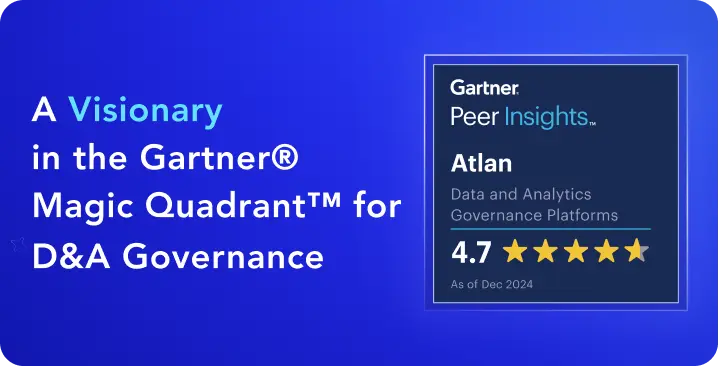Data Discovery in Manufacturing: Improve Decision-Making, Compliance, and Innovation
Share this article
Manufacturers generate vast amounts of data from IoT sensors, production lines, supply chains, and quality control systems. However, much of this data remains trapped in silos, limiting its potential to drive efficiency and innovation.
See How Atlan Simplifies Data Governance – Start Product Tour
Through effective data discovery in manufacturing, organizations can break silos and identify, catalog, and understand their data assets. This enables predictive maintenance, optimized production schedules, and improved operational efficiency.
In this article, we’ll explore the role of data discovery in manufacturing, its benefits and challenges, and how a metadata control plane can help.
Table of contents #
- What is data discovery in manufacturing?
- The business benefits of data discovery in manufacturing
- Top challenges of data discovery in manufacturing
- Data discovery in manufacturing: How a metadata control plane can help
- Data discovery in manufacturing: Improving efficiency, innovation, and compliance
- Data discovery in manufacturing: Related reads
What is data discovery in manufacturing? #
Data discovery in manufacturing involves systematically exploring, analyzing, and leveraging data stored across diverse systems—such as production lines, IoT sensors, supply chains, and quality control systems—to uncover actionable insights.
Data discovery helps manufacturers break down data silos, uncover hidden patterns, and improve decision-making across operations.
For example, real-time sensor data from factory equipment can reveal inefficiencies in machine performance, while supply chain analytics can help predict delays and optimize inventory levels.
The business benefits of data discovery in manufacturing #
Data discovery helps manufacturers unlock value from their data and gain several key benefits, such as:
- Cost savings: Manufacturers can discover and analyze real-time and historical data to spot inefficiencies in production, supply chain, and resource allocation. This helps reduce material waste, optimize energy consumption, and lower operating costs.
- Operational efficiency: Data discovery provides a unified view of production processes by aggregating data from various systems like IoT sensors, ERP platforms, and production line logs. With better visibility into workflows, manufacturers can reduce bottlenecks, enhance supply chain coordination, and improve overall productivity.
- Reduced production delays: Through real-time data discovery, manufacturers can proactively track inventory levels, machine performance, and supplier timelines. Connecting these data points allows businesses to anticipate shortages, adjust schedules, and prevent costly production delays.
For instance, a manufacturing facility using real-time data discovery to analyze demand fluctuations can dynamically adjust its production to meet customer needs.
- Proactive maintenance: Predict and prevent equipment failures by analyzing sensor data, maintenance logs, and historical breakdown patterns. With predictive maintenance, companies can schedule repairs before failures occur, reducing downtime and extending equipment lifespan.
- Improved quality control: Data discovery also centralizes quality control data from production lines, inspections, and customer feedback. So, a company analyzing defect reports through data discovery can fine-tune manufacturing parameters to reduce errors. They can spot trends in defect rates and conduct root cause analysis, enabling them to make real-time adjustments.
- Compliance support: Data discovery simplifies regulatory compliance by centralizing data classification, audit logs, and security policies. Manufacturers can track how sensitive data flows across systems, ensuring regulatory compliance and preventing unauthorized access.
- Improved innovation: By discovering patterns and correlations in production and market data, manufacturers can accelerate R&D and drive product innovation.
Top challenges of data discovery in manufacturing #
While data discovery in manufacturing unlocks valuable insights, it also comes with challenges, such as:
- Cross-departmental data silos: Manufacturing data is often scattered across departments, from production and logistics to procurement and quality control. This fragmentation makes it difficult to gain a unified view of operations, leading to inefficiencies.
- Integrating multiple data sources: Manufacturers rely on various systems like SCADA, MES, and ERP, each generating large volumes of structured and unstructured data. This can hide valuable insights into disconnected systems.
- Legacy systems: Many manufacturing facilities still operate on outdated systems that lack compatibility with modern data discovery tools. These systems limit visibility, slow down decision-making, and hinder process improvements.
- Privacy and compliance requirements: Manufacturing data also includes sensitive customer information, supply chain details, and proprietary production methods. Ensuring compliance with regulations like GDPR and industry-specific mandates requires properly identifying, classifying, and securing sensitive data, often across a global network.
Data discovery in manufacturing: How a metadata control plane can help #
Effective data discovery in manufacturing requires a structured approach to managing and accessing data across fragmented systems. A metadata control plane provides a single platform where manufacturers can search, discover, access, and govern data assets across all systems—ensuring that engineers, production managers, and supply chain teams work with accurate, trusted information.
A metadata control plane also enables end-to-end visibility, automation, and governance—critical for manufacturers dealing with vast amounts of production data, supply chain metrics, quality control records, and regulatory requirements.
By integrating with both legacy and modern systems, it ensures that all data—from IoT sensor readings and maintenance logs to production schedules and compliance reports—is available and governed uniformly across the organization.
Also, read → The unified control plane in action
Essential capabilities to look for in such a unified control plane include:
- Google-like search with natural language processing: Quickly search for production metrics, machine logs, supply chain reports, and datasets across multiple platforms using natural language search. Users can find relevant assets linked to business metrics, discover related data sources, and retrieve insights despite typos or keyword variations.
- Metadata filters: Filter data assets based on ownership, classification, certification status, data source, last update timestamps, and other metadata attributes to refine search results and streamline discovery.
- Auto-profiling for data quality assurance: Understand the structure, completeness, and accuracy of manufacturing data, highlighting missing values, inconsistencies, or anomalies that could affect production efficiency or compliance.
- 360-degree visibility with embedded collaboration: Provide a unified view of manufacturing data assets, supporting contextual discussions, ticketing, and real-time issue resolution within the platform – without switching apps.
- Cross-system, column-level actionable data lineage: Track the flow of data across manufacturing operations—from raw material sourcing and equipment logs to finished goods tracking—ensuring full visibility into data transformations and dependencies.
- Granular access control and governance: Set customized permissions for viewing, editing, or sharing manufacturing data depending on user role, data domain, projects, and more. This ensures secure handling of sensitive operational information while enabling teams to leverage the right data for decision-making.
- Real-time monitoring and automated alerts: Continuously track data usage, detect anomalies, and trigger alerts for potential compliance violations, equipment malfunctions, or supply chain disruptions.
Also, read → Data search and discovery in Atlan | Using filters to refine your search results | How to automate data profiling | Asset profiles for complete context | What is data lineage? Tracking the journey of your data
How Aliaxis enhanced data discovery and improved focus on delivering value #
Aliaxis, a global leader in the manufacture and distribution of plumbing and water solutions, wanted to demystify a complex data estate. As an organization with over 15,000 employees in 40+ countries, unlocking the full value of its data required improving data governance maturity and streamlining data discovery.
To achieve this, Aliaxis adopted Atlan as its modern data catalog, with capabilities such as active metadata management, automated lineage, and a global business glossary.
This transformation improved visibility into their vast data estate, enabled self-service data discovery, and empowered teams to focus on delivering value–developers are focusing on delivering value with data, rather than having to troubleshoot and spend time digging through code finding where pipelines broke.
“When data is properly documented and data products are easy to find, our business partners can answer questions without jumping through hoops trying to find the right owner, then waiting for busy people to respond. In terms of time savings, this is significant.” - Nestor Jarquin, Global Data & Analytics Lead at Aliaxis
Data discovery in manufacturing: Improving efficiency, innovation, and compliance #
Data discovery in manufacturing is essential for identifying, cataloging, and understanding data assets across production systems, supply chains, and operations. A metadata control plane enables manufacturers to break down data silos, improve governance, and enhance collaboration—driving faster insights, self-service analytics, and real-time monitoring of production processes.
As the industry moves toward digitization and AI-driven manufacturing, adopting a metadata control plane is key to ensuring scalable, secure, and AI-ready data discovery. This empowers manufacturers to optimize efficiency, reduce downtime, ensure regulatory compliance, and drive continuous innovation.
Data discovery in manufacturing: Related reads #
- What is data discovery? Understand the concept of data discovery and its importance in finding and organizing data.
- Data governance in manufacturing: A complete guide on the need for data governance in manufacturing, its benefits, best practices and implementation strategies.
- What are data silos? Explore how data silos hinder decision-making and how to overcome them for better data collaboration.
- What is data governance? Learn how data governance is essential in banking for regulatory compliance and securing customer data.
- How enterprise data catalogs drive business value
- Unified control plane for data: The future of data cataloging
- Data Governance in Fintech: Outcomes & Best Practices
- Financial Data Governance: Strategies, Trends & Best Practices
- Key Objectives of Data Governance: How Should You Think About Them?
- Data Governance Strategy: How To Get Started?
- Data Governance Framework: Examples, Templates, Standards, Best Practices & How to Create One?
- Data Governance and Compliance: Act of Checks & Balances
- How to implement data governance? Steps, Prerequisites, Essential Factors & Business Case
- How to Improve Data Governance? Steps, Tips & Template
- 7 Steps to Simplify Data Governance for Your Entire Organization
- Automated Data Governance: How Does It Help You Manage Access, Security & More at Scale?
- Enterprise Data Governance: Basics, Strategy, Key Challenges, Benefits & Best Practices
- Data Governance in Insurance: Why is it Important and How it Drives Positive Business Outcomes
- Data Governance in Healthcare: Benefits, Framework, and Tooling
- Metadata Management: Benefits, Automation & Use Cases
- Data Governance Policy: Examples & Templates
- Unlocking Data Governance with Data Lineage
- 10 Data Governance Challenges & How to Overcome Them!
- Data Privacy vs. Data Security: Definitions and Differences
- What is Data Reliability? Examples, How to Measure & Ensure!
- Data Compliance: Everything You Need to Know in 2025!
- Data Compliance Management: Concept, Components, Steps (2025)
Share this article











